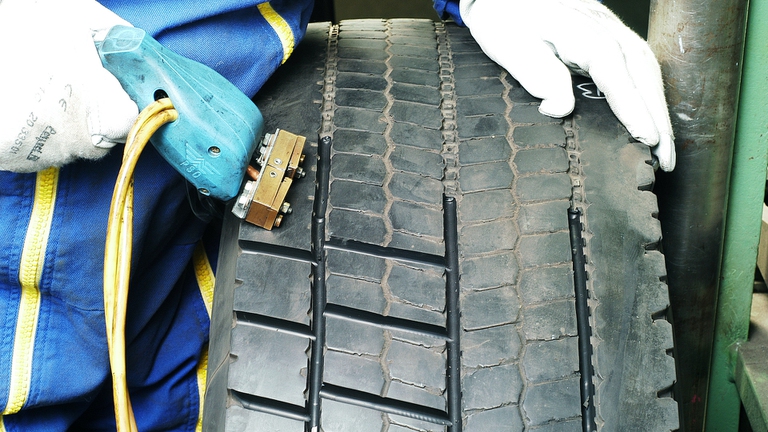https://www.lifegate.it/video/lifegate-talk-logistica-pneumatici
- |
The appointment with is back LifeGate Talk, debates with solutions on sustainable mobility, this time dedicated to logistics, a sector that plays a decisive role in reducing the environmental impact of transport.After exploring topics such as the air quality, theenergy, thelast mile and the urban micromobility, in the new meeting, together with the guests present in the studio, we examine the implications of logistics practices on the environment, the potential contribution to sustainable mobility and, above all, the challenges that companies in the sector must overcome to improve their ecological footprint.As usual, the talk does not limit itself to highlighting the problems, but explores innovative technologies and future strategies, offering solutions and recommendations to promote a sustainable evolution of the sector.
The importance of logistics in sustainable mobility
The starting point is the data collected by the Polytechnic University of Milan according to which carbon dioxide emissions deriving from the transport of goods by road represent the thirty percent of total emissions of road transport.Is it possible to reduce this percentage?Absolutely yes.For example, through the adoption of new organizational and production models, interventions on the management and efficiency of fleets, as well as the electrification of vehicles, as recommended by the United Nations during the first World Sustainable Transport Day last November.It is essential to recognize that each component of the supply chain plays a key role for sustainability which must be considered both in environmental and social terms, paying increasingly more attention also to human capital and worker well-being.

During the talk, the little-known but crucial topic of life cycle of tires and their recycling practices.Considering that, according to Eurostat, over eighty percent of goods are transported by road, it becomes essential to promote a sustainable management along the entire supply chain.The recycling and the reconstruction of tires emerge as useful practices not only for reducing waste and emissions, but also for allowing high savings in resources and costs.
These premises constitute the starting point for the debate moderated by Roberto Sposini, journalist, chief mobility editor of LifeGate.To discuss with him: Giuseppina Carnimeo, general manager of Ecopneus; Martina Castoldi, co-founder of Tiaki logistics; Guido Gambassi, general secretary of the Italian Association of Tire Retreaders (Airp);And Enrico Spinelli, sales director of Michelin Italian.
The social challenges of logistics
The first question that Roberto Sposini asks his guests concerns the main challenges of the sector:What are the possible solutions and best practices and how many are there?For Martina Castoldi, co-founder of Tiaki Logistics, the first web platform dedicated to sustainability in logistics, despite the progress in environmental sustainability, there is still a lot to do on the sustainability front social sustainability, in particular on workers' rights and corporate social responsibility.
Irregularities in supply contracts require greater regulation and transparency.In this regard, Tiaki has launched a service on its digital platform to analyze and optimize contractual fairness, allowing companies to upload contracts and receive suggestions for improvements.At this time, it is crucial to invest in the training and well-being of workers to promote a fair and sustainable working environment, while at the same time making the sector more attractive and increasing the trust of consumers and partners.
The four tire lives:towards more sustainable and conscious management
But, as anticipated, during the debate an interesting focus is also made on role of tires, enriched first and foremost by the presence and expertise of Enrico Spinelli of Italian Michelin, a leading company in the sector.
Michelin actively engages in a model of circular economy, aiming to maximize the reuse of raw materials and close the sustainability cycle, supporting companies in the sustainable technical management of tires, a fundamental practice within its sustainable strategy All sustainable, which is the basis of the broader corporate vision Michelin in motion, which it aims to achieve zero emissions by 2050, with intermediate objectives such as reducing carbon dioxide emissions in the production process by fifty percent by 2030.
The All sustainable approach which materializes in the Michelin in motion strategy tends to improve the mobility of our customers, mainly developing three domains:the tire part, the high-tech materials and the connected solutions.
The company pays particular attention to second life of the product and oneco-design to maximize the reuse and recyclability of materials from its initial design stages.The concept of the is interesting “four lives” of the tire:an approach that includes practices such as resculpting and the reconstruction which, by renewing the tread once it has worn out, extend the useful life of the tires and help save raw materials and reduce carbon dioxide emissions.
Recycling and reconstruction:the life cycle of tires
As pointed out by Giuseppina Carnimeo Of Ecopneus, tires are a perfect example of a circular economy since, once their primary function has ended, they can be transformed into new valuable resources for different applications.Ecopneus, a non-profit company, plays a crucial role in this process, supporting companies in their responsibility for tire recovery and recycling.

There recycled rubber from tires that have reached the end of their life, it finds various applications in the most disparate fields.In road pavements improves the quality of infrastructure, reducing noise and increasing the durability and resistance of roads;on sports surfaces, such as basketball courts, paddle courts and gyms, it offers elasticity and cushioning;in construction it can be used as acoustic insulation or anti-slip coating;and in animal welfare, it is used to produce 'cow shoes', rubber grafts that help correct the lameness of cattle.
The tire retreading technique, on the other hand, allows used tires to be reused, transforming them into almost new products with characteristics comparable to the original ones.As highlighted by Guido Gambassi Of Airp, this process saves 70 percent of raw materials, 67 percent of energy and 35 percent of carbon dioxide emissions during production, as well as decreasing global emissions by 95 percent, also considering transportation .

This technique not only offers significant environmental benefits, but also allows for a significant reduction in costs, both for producers and consumers.And all this at equal security, since retreading is regulated by specific approval standards which make retreaded tires technically comparable to new ones, dispelling the myth - widely spread in the world of mobility - which considers retreaded tires less safe than new ones.
In short, with the growing environmental impact associated with freight transport, the adoption of responsible practices such as tire retreading and rubber recycling are not only an ecological necessity, but also an economic opportunity.Looking to the future, it is essential that the industry continues to evolve towards solutions that prioritize durability and recyclability, pushing the limits of sustainable innovation.
LifeGate Talk:the format
The LifeGate talk format offers a series of educational digital talks and debates with studio guests to trigger a discussion on the major issues related to sustainable mobility and propose solutions to the critical issues related to them.
Read also:
- LifeGate talk is born:debates, with solutions, on sustainable mobility
- LifeGate talk, the new event is dedicated to air quality
- LifeGate talk, climate change and how to stop it
- LifeGate talk, last mile and electric transition:let's talk about it
- LifeGate talk, let's talk about micromobility and safety
